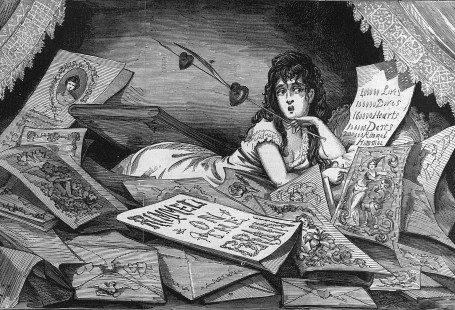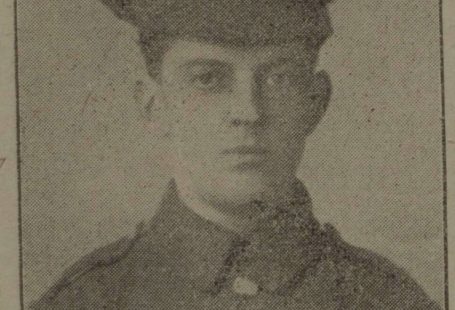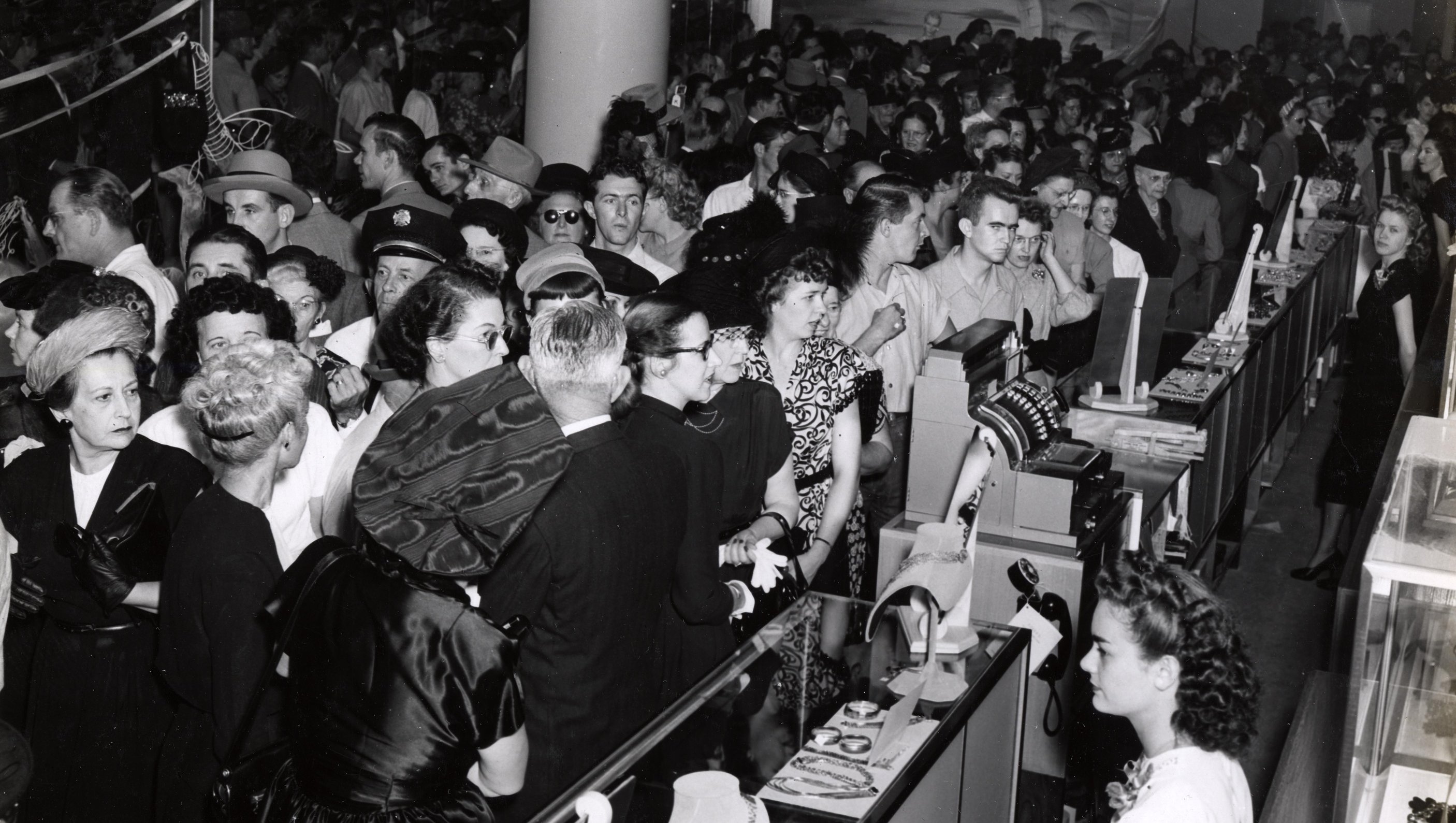Not only did the flapper turn on its head traditional notions of femininity – she was arguably the first incarnation of youth culture in Britain and beyond. She was a good time girl, she drank, she smoked, she drove, she partied, she wore the latest outrageous fashions, she came home late – and in doing so, she preempted the youth culture movements of later decades.
A study by Domergue | The Tatler | 3 June 1925
In this special blog, we explore what being a flapper meant in the 1920s, using contemporary articles sourced from the pages of the British Newspaper Archive.
Want to learn more? Register now and explore The Archive
An American Flapper in London
In June 1922 a wonderfully satiric letter by Edna Huber Church appeared in The Bystander. Writing to her sister from London Town, ‘in between dances,’ an American flapper relates the latest news in her busy, hedonistic life. But first of all she apologises that she hasn’t written for so long because she has ‘been so busy dancing around I really haven’t had a minute to myself.’
Our American flapper has had an unsuccessful romance with a British Major; he was sadly discarded because he didn’t know how to foxtrot. ‘Imagine! I could never be happy married to a man who doesn’t fox-trot.’ But that didn’t stop our letter writer from making hay:
We, meaning the Maje and myself and some of his ducky friends, have touched all of the high spots and with all six cylinders hitting in high. We have danced in every hotel and night club in Town, and there are scads of them, loveliest places you ever kicked a toe in. I’d better just explain that night clubs are just dancing places. I don’t know why they call them that, except it has something to do with some L.C.C., whoever he is. From my pink shell ears, Mr L.C.C. is the official gloom of London Town.
She goes onto to relate the joys of a trip to the theatre – a ‘chance to drink and grow merry. If you are thirsty you can dash out to the promenade at the end of the first act and get a shot of honest to goodness liquor, not hooch, my dear, liquor.’
Huber Church’s depiction of this lovable but ditsy American flapper confirms the stereotype of a fun-loving figure, who enjoys nothing better than drinking and dancing, perhaps to the detriment of everything else. But just a few short years after the horrors of the First World War, it is easy to understand how a nation’s youth might want to turn to fun and frivolity in order to escape the tragedy of what went before.
The Wild Party
Perhaps one of the most famous flappers in the world was actress Clara Bow. In 1929, she appeared in her first ‘talkie,’ ‘The Wild Party.’ According to the Illustrated Sporting Dramatic News, the ‘story concerns life at girls’ college, with Clara Bow as the heroine and leader of the notorious Hair-Brained Maidens.’
Clara Bow and the Hair-Brained Maidens | The Sketch | 20 February 1929
These ‘Hair-Brained Maidens,’ consisting of Bow, as well as Adrienne Dore, Alice Adair and Jean Lorraine, were hell-raisers, and one scene in the film sees them getting kicked out of a party for wearing ‘too scanty dresses.’
The Sketch calls the film a ‘shoutie,’ rather than a ‘talkie,’ the phrase that would of course catch on. But this is perhaps appropriate for a film that raucously celebrates the new found freedoms of women – being able to party, and to wear whatever they like (although, of course, the party organisers did not approve!).
Good Girl in Net Stockings
Women’s new found freedoms manifested themselves in the fashions of the time. They cut their hemlines short, and their hair even shorter.
The bob hairstyle, so integral to that flapper look, was in itself revolutionary. Inspired by the likes of actresses Louise Brookes, Clara Bow, Colleen Moore and Marion Davies, soon women across the world were cutting their hair short. This was a daring challenge to the status quo, and represented an emancipation from the cultural and ideological trappings of traditional femininity.
As an article in Britannia and Eve relates in 1929, ‘When woman first turned her attention to bobbing and shingling her hair, perhaps she dispensed with a greater part of the care which her mother and grandmother took to keep their hair well brushed and combed.’
It was not just their hair that women were dispensing with. They were dispensing with tradition.
And short dresses and skirts represented another departure from the rather too recent past of hobble skirts, and prude Victorian values of hidden legs and corsetry. Legs were suddenly something to be seen, to be looked at, and to be admired. The fashion world responded accordingly, and stockings became the accessory of the hour.
Here, Miss Elsie Randolph, who was starring in a production called ‘That’s a Good Girl’ by Jack Buchanan, wears the latest in hosiery. These ‘dainty stockings…look as though they were made of net.’
Elsewhere, women were doing the unthinkable – wearing trousers. This was another rebellion against traditional gender roles, although The Tatler is quick to make this advance in female fashion palatable to its readers.
In featuring a couple of ‘pyjamas for the bateau’ – namely ‘trousers of white flannel with woollen sweaters’ – the writer is swift to point out that ‘the trousers are so voluminous that a division does not show.’ In other words, it is not obvious that one is wearing trousers, and so suddenly these ‘newest things in the world of dress’ are not so controversial after all.
Eagerness of Youth
We have looked at film portrayals of flappers, of satirical portrayals of flappers, but now we turn to a description of flappers in Birmingham, attending a local ‘hop.’ The anonymous writer in the Birmingham Daily Gazette sets the scene:
Dancing is in full swing, and the floor is comfortably crowded. Most of the refreshment tables are occupied either by couples or parties. You will note that the ‘drinks’ are of the most innocuous character, nothing more than lemonade, coffee, etc. A jazz band is playing what some of the dancers would describe as a ‘snappy’ fox-trot, and the rhythmic infection of it is visible everywhere.
The flappers here are not big drinkers. They are enjoying the music, and simply being young: ‘the eagerness of youth radiates a physical vitality which spreads itself in the joyousness of the dance.’
And that, in essence, was what it meant to be a flapper in the 1920s – enjoying the moment, enjoying the novelty of the new things available to them, fashions, music, greater freedoms. They were busy seizing the day, the day that had been denied to the youth of the decade before.













